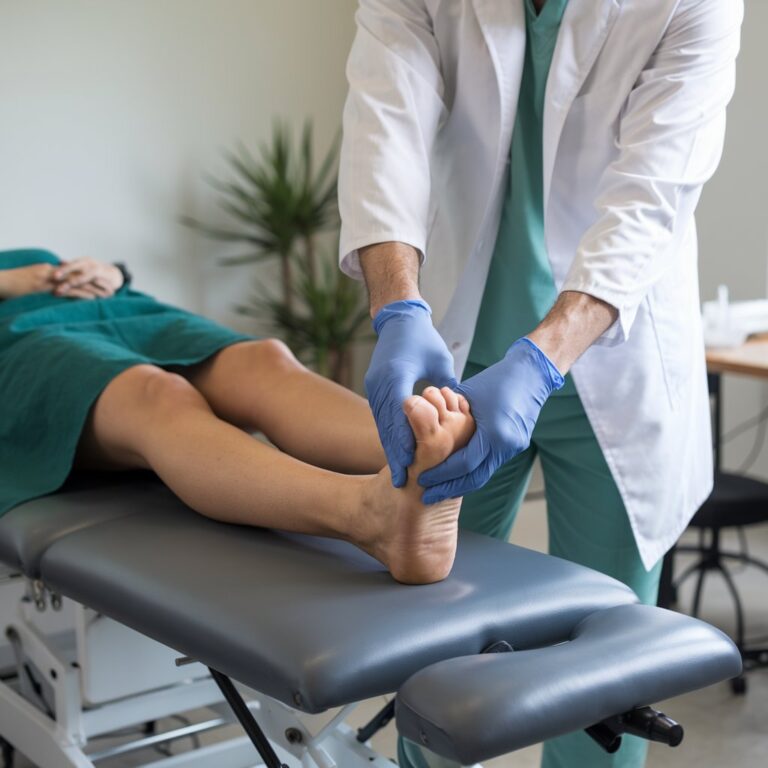Understanding Plantar Interossei Muscles
Imagine you’re on a day of hiking, with the sun shining bright and trails full of adventure. Your feet work hard to keep you upright and moving. But you might not think about the muscles under your feet that help you walk smoothly.
These muscles, called the plantar interossei, are small but powerful. They are in the middle of your foot’s sole. They help your toes move and pull together, especially at the joints connecting your toes to the foot bones. Without them, walking would be hard and balance would be off.
We will explore more about these muscles and their role in our movement. We’ll see how they help us walk and why they are important. Let’s learn more about these key foot muscles.
Table of Contents
What Are Plantar Interossei Muscles?
The plantar interossei muscles are three muscles found between the metatarsal bones III to V. They are key in foot anatomy, giving strength and stability. Each muscle starts from the medial side of metatarsal bones 3, 4, and 5.
These muscles help move the third, fourth, and fifth toes together. This action is crucial for keeping the foot aligned during walking and running. They also help support the metatarsal arch, along with the dorsal interosseous muscles, making the foot work properly.
The lateral plantar nerve, a branch of the tibial nerve, supplies these muscles. They are in the deepest layer of the foot. Understanding these muscles helps us see how they work and what happens if they’re not right. Changes in how they attach can lead to foot problems.
Anatomy of Plantar Interossei
The plantar interossei muscles are key to the foot’s anatomy and function. They sit in the foot’s central compartment, under the metatarsal bones, right above the flexor digitorum brevis. These muscles are smaller than their dorsal counterparts and are deep to other muscles like the adductor hallucis. This placement helps them work uniquely in foot mechanics.
Location Within the Foot
There are three plantar interossei muscles between the third, fourth, and fifth metatarsals. They start from the lower, inner sides of these bones. Their main job is to help keep the toes stable and in the right position during walking and running.
They stop the toes from spreading too much when you put weight on your forefoot. This helps keep balance and alignment during pushing off the ground.
Classification in Foot Muscles
The plantar interossei are in the fourth layer of foot muscles. They work closely with muscles like the flexor digitorum brevis and the dorsal interossei. Their position shows how important they are in controlling foot movements and helping with actions like bending the joints between the toes and the foot.
Their unique position and classification highlight their key role in foot mechanics.
| Muscle | Location | Function |
|---|---|---|
| Plantar Interossei | Between 3rd, 4th, and 5th metatarsals | Stability and toe positioning |
| Dorsal Interossei | Between metatarsals 1-5 | Abduction of toes |
| Flexor Digitorum Brevis | Below metatarsals | Toe flexion |
Origin and Insertion of Plantar Interossei
The plantar interossei are key muscles in the foot. They help with stability and movement of the toes. Knowing where they start and end shows how they help with toe bending and moving together.
Origin Points
These muscles start on the inner sides of the 3rd, 4th, and 5th metatarsal bones. This spot is important for the muscles to work right. It helps them move the toes and keep the foot stable during various activities.
Insertion Points
The muscles end at the inner bases of the first bones of toes 3, 4, and 5, and the extensor expansion. This setup lets them do their main jobs. They help with the push-off in walking and running, making sure toes bend and move together well.
| Muscle | Origin Points | Insertion Points | Function |
|---|---|---|---|
| Plantar Interossei | Medial sides of 3rd, 4th, and 5th metatarsal bones | Medial bases of proximal phalanges of toes 3-5, extensor expansion | Adduction of toes 3-5, assists in toe flexion |
Relations of Plantar Interossei Muscles
The plantar interossei muscles are key in the complex workings of the foot. They sit under the dorsal interossei and are surrounded by other muscles. These interactions help with walking, running, and moving the foot.
These muscles are found between the metatarsals, below the third layer of the foot’s muscles. They work with muscles like the flexor hallucis brevis and adductor hallucis. The plantar metatarsal arteries also run alongside them, showing their importance.
Together with the dorsal interossei, these muscles help the foot stay stable and move. The plantar interossei are crucial for moving the toes, especially flexing and moving them inward. This shows how muscles work together to keep the foot working right.
| Muscle | Relation to Plantar Interossei |
|---|---|
| Flexor Hallucis Brevis | Superficial muscle contributing to hallux flexion |
| Adductor Hallucis | Supports stabilization of the big toe |
| Flexor Digiti Minimi Brevis | Aids in flexion of the fifth toe |
| Plantar Metatarsal Arteries | Provide blood supply alongside muscle function |
| Dorsal Interossei | Assist in toe abduction, complementing plantar interossei actions |
Function of Plantar Interossei
The plantar interossei muscles are key to how the foot moves. They work on the metatarsophalangeal joints and help with foot movement. These muscles help with bending the toes and work with others for balance and stability.
Actions on Metatarsophalangeal Joints
These muscles bend the toes at the metatarsophalangeal joints of the third to fifth toes. This bending is important for walking and running. It helps support and align the toes.
They also bring the toes together, towards the body’s middle. This helps keep the foot stable and stops the toes from spreading too much when you’re standing or walking.
Role in Foot Dynamics
The plantar interossei muscles are crucial for controlling foot movement in different activities. They help position the toes for pushing off during movement. This keeps the toes in the right place and helps with overall foot movement.
Strengthening these muscles can make you perform better and lower the chance of getting hurt. Walking barefoot or gripping a towel with your toes can help make these muscles stronger. Knowing how important these muscles are can help prevent foot problems.
For more information on how muscles affect health, check out related topics like hormonal balance and health implications.
| Action | Impact on Movement | Related Muscles |
|---|---|---|
| Flexion at Metatarsophalangeal Joints | Enables effective push-off during gait cycles | Toe Flexors, Dorsal Interossei |
| Adduction of Toes | Maintains toe alignment and stability | Intrinsic Foot Muscles |
| Regulation of Foot Dynamics | Supports arch integrity and prevents instability | Other Plantar Muscles |
Innervation and Blood Supply of Plantar Interossei
The plantar interossei muscles are key to how our feet work. They need the right innervation and blood supply to function well. Knowing about these helps us understand muscle health and issues with the lateral plantar nerve and artery.
Innervation by the Lateral Plantar Nerve
The deep branch of the lateral plantar nerve innervates the plantar interossei. This nerve comes from the tibial nerve and is linked to spinal segments S2-S3. Good innervation is key for these muscles to move the foot properly.
Blood Supply Mechanisms
The plantar interossei get the blood they need from several arteries. The lateral plantar artery, a branch of the posterior tibial artery, is crucial for blood flow. The deep plantar arch and plantar metatarsal arteries also help feed the muscles. Good blood flow is important for muscle strength, especially when walking or running.
| Aspect | Details |
|---|---|
| Innervation Source | Deep branch of the lateral plantar nerve (S2-S3) |
| Primary Blood Supply | Lateral plantar artery |
| Additional Blood Supply Sources | Deep plantar arch, plantar metatarsal arteries |
| Functional Importance | Essential for muscle health and performance during locomotion |
Clinical Significance of Plantar Interossei
The plantar interossei muscles are key to keeping the foot working right. If they don’t work well, it can cause foot problems that affect how you move and your daily life. It’s important to understand their role for proper diagnosis and treatment.
Impact of Dysfunction
When the plantar interossei don’t work right, it can lead to claw toe problems. This happens often with conditions like Charcot-Marie-Tooth disease, which affects muscle control. Doctors need to spot these issues to treat the root cause of foot problems.
These muscles also help keep the third, fourth, and fifth toes in the right position when you walk or run. Without them, toes can move wrong, putting pressure on other parts and changing how you move. Checking on these muscles can give doctors clues about your foot health.
| Plantar Interossei Dysfunction Issues | Associated Conditions | Symptoms |
|---|---|---|
| Claw Toe Deformities | Neurological Disorders | Pain in toes and forefoot |
| Muscle Weakness | Charcot-Marie-Tooth Disease | Instability while walking |
| Toe Misalignment | Flatfoot or High Arches | Altered gait patterns |
Knowing about the plantar interossei helps doctors tackle foot disorders better. This leads to better treatment for people with related symptoms.
Differences Between Plantar and Dorsal Interossei Muscles
The plantar and dorsal interossei muscles are key to the foot’s movement. They have different anatomical locations and functions. The plantar interossei are on the bottom side and help pull the toes together. This is crucial for keeping the foot stable while moving.
The dorsal interossei, on the other hand, are on the top side. They spread the toes apart. This lets us move our feet more and helps with balance when walking or running. Knowing how they work helps us understand their differences.
| Feature | Plantar Interossei | Dorsal Interossei |
|---|---|---|
| Location | Plantar side of the foot | Dorsal side of the foot |
| Primary Function | Adduction of toes | Abduction of toes |
| Number of Muscles | Three muscles | Four muscles |
| Innervation | Lateral plantar nerve | Deep peroneal nerve |
| Role in Foot Mechanics | Stabilization during movement | Enabling foot flexibility |
The differences in where they are and what they do show how important each muscle is. Knowing about these differences helps us understand foot health and how well the foot works.
Importance of Plantar Interossei in Lower Extremity Muscles
The plantar interossei are key to the lower extremity muscles. They help keep the toes stable and aid in movement for walking and running. Without them, moving the foot would be harder, leading to injuries or problems.
Studies show these muscles help keep the arch of the foot stable. If they’re weak, it can cause foot problems like hallux valgus and claw toe. Weak muscles are linked to conditions like Charcot-Marie-Tooth disease and heel pain.
Effective strength measurement is key to checking muscle health. It shows that weak toe muscles can make older adults more likely to fall. But, strengthening the hallux can lower this risk, showing how crucial these muscles are for balance.
The plantar interossei work with other muscles to make walking easier. They help keep the foot stable during walking. For athletes or those who are active, strengthening these muscles helps improve performance and prevent injuries.
For more on how muscles affect health, visit Understanding Mental Health. Learning about foot mechanics shows how vital these muscles are for movement and overall health.
How Plantar Interossei Affect Balance and Movement
The plantar interossei are key to keeping balance and helping with movement in the foot. They make sure the toes line up right, which is key for staying stable while walking or running. These muscles work together to control how much the arch bends with each step, making movement smoother.
Each foot has 19 muscles, and the plantar interossei team up with others for balance. They support the foot’s three arches, like the medial, lateral, and transverse arches. The medial arch is especially important for absorbing shock and keeping stable during hard landings.
When you need quick moves, the plantar interossei keep the toes in line and ready. They’re important for sports and exercises that need precise footwork. Doing exercises that focus on these muscles can make balance better and lower injury risk.
Keeping your hormones balanced with the right food and exercise can also help your muscles, like the plantar interossei. This shows how hormones, muscle health, and movement are connected. For more on how testosterone affects your body, check out this link.
The Role of Plantar Interossei in Foot Physiology
The plantar interossei muscles are key to how our feet work. They help keep our feet moving and balanced. These muscles are in the middle of the foot and play a big part in how we move and spread our weight.
Contributions to Overall Foot Mechanics
There are 14 muscles in the foot’s sole, and the plantar interossei are vital for walking and running. They do several important jobs:
- Toe Movement: They help pull toes III, IV, and V together, making us stable and balanced.
- Arch Support: By flexing the toes, they help keep the arch strong, which is key for spreading our weight evenly.
- Joint Action: They help extend the toes, which is important for walking and running smoothly.
Knowing how our feet work is important for spotting problems. If the plantar interossei are weak, it can cause toes to curl up, showing how crucial they are for keeping our feet right.
| Function | Description |
|---|---|
| Adduction | Bringing toes III, IV, and V closer to the midline of the foot via contraction. |
| Toe Flexion | Facilitating flexion at the metatarsophalangeal joints, promoting better ground contact. |
| Arch Maintenance | Supporting the metatarsal arch during dynamic activities, enhancing stability. |
| Nervous Innervation | Innervated by the lateral plantar nerve, ensuring optimal function and responsiveness. |
The plantar interossei muscles are vital for how our feet work. They help us move and support us, which is important for everyone, not just athletes.
Plantar Interossei in Relation to Other Foot Muscles
The plantar interossei are key in how the foot moves, working closely with the toe flexors. These muscles are in the foot’s center and help with walking, running, and jumping. They work with other muscles to make sure the foot moves right.
Interaction with Toe Flexors
The plantar interossei and toe flexors work together for good foot function. They help with:
- Toe Flexion: This is important for gripping the ground and staying balanced.
- Toe Adduction: They move the third, fourth, and fifth toes together, helping the toe flexors.
- Stability: They work together to keep the joints stable when you’re standing or moving.
These muscles start from the sides of the bones in the foot and attach to the toes. They work well with the toe flexors to make the foot flexible for different activities.
| Muscle Group | Origin | Insertion | Main Actions |
|---|---|---|---|
| Plantar Interossei | Medial aspects of metatarsals 3-5 | Medial bases of proximal phalanges and extensor expansions of digits 3-5 | Toe adduction, flexion at metatarsophalangeal joints |
| Toe Flexors | Various points along the posterior aspects of the foot | Bases of proximal phalanges | Toe flexion, movement stabilization |
The plantar interossei and toe flexors work together for the best foot movement and stability. Knowing how they work can help improve sports performance and fix foot problems.
Exploring Plantar Interossei in Human Anatomy
The plantar interossei muscles are key in human anatomy, especially in foot studies. They are three small muscles in the foot’s central compartment. These muscles help with toe movement, bringing toes together, and extending them. They connect to the 3rd to 5th metatarsal bones and get nerve signals from the lateral plantar nerve.
These muscles are vital for keeping the foot stable and moving right. They make sure the foot works well.
Looking into the plantar interossei can help us understand foot problems better. For example, some people have these muscles attached differently, which can affect how they walk. This can lead to issues like a hallux valgus deformity. Knowing about these differences helps doctors treat foot problems better.
Learning about plantar interossei helps doctors diagnose and treat foot issues. It also shows us more about how our bodies work together. For more on how being aware of our bodies can help us, check out mindfulness practices that improve our health.
FAQ
What are the plantar interossei muscles?
Where are the plantar interossei located?
What functions do the plantar interossei serve?
How are the plantar interossei innervated?
What happens if the plantar interossei muscles do not function correctly?
How do the plantar interossei muscles differ from the dorsal interossei?
What is the blood supply to the plantar interossei?
Why are the plantar interossei important in lower extremity exercises?
In what ways do the plantar interossei affect balance and movement?






